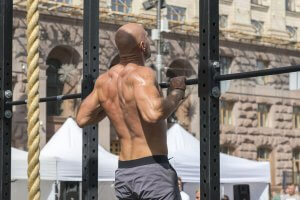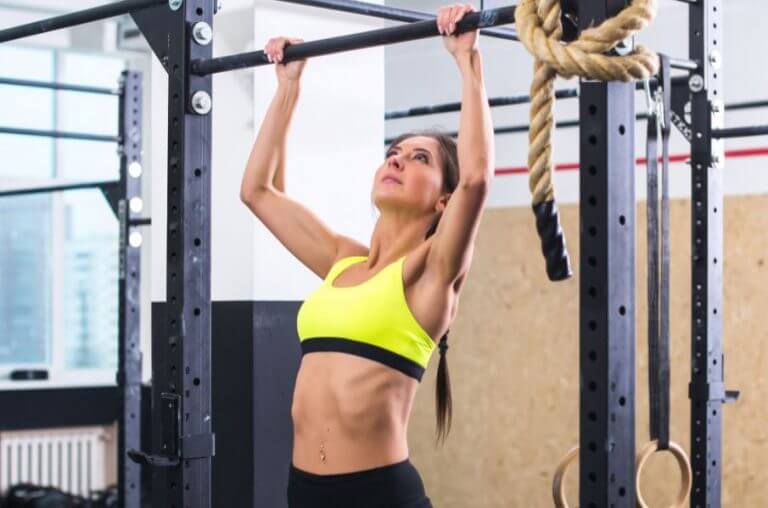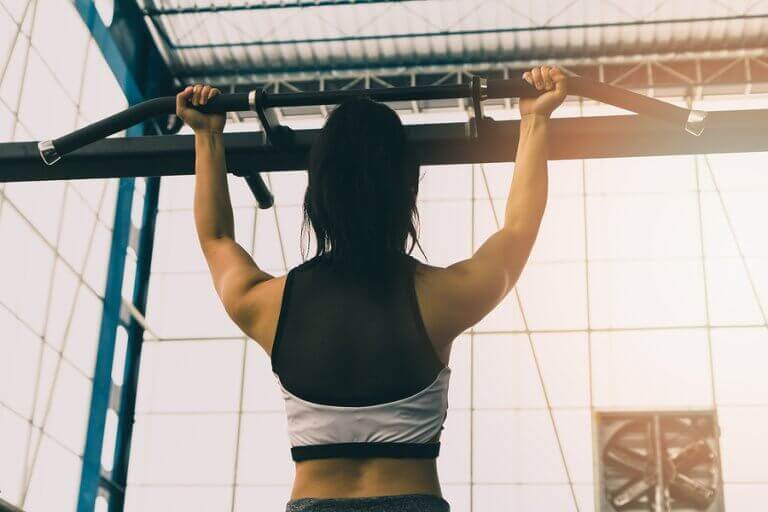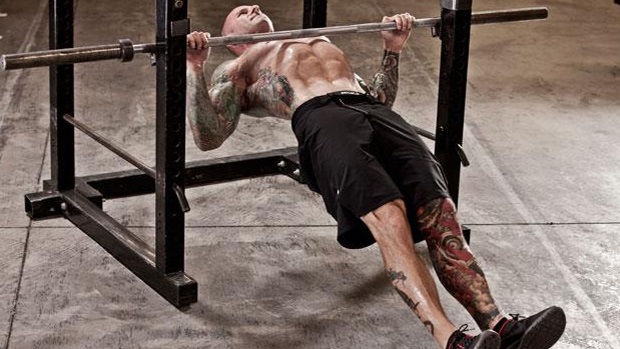Working out on a Pull-Up Bar

Weights, machines and other gym accessories help us sculpt our bodies. But a simple pull-up bar and your own body weight can work wonders. Many people rely on pull-ups and chin-ups for a big part of their workouts.
Backs usually endure the biggest and most direct impact on these kinds of workouts. Back muscles make up the second-largest muscle set in the human body. But besides the back, pull-up bar exercises also affect other areas as well.
The muscles you can work out on a pull-up bar
You can essentially work out any core muscle on a pull-up bar. In the traditional vertical pose, you can work out your triceps, back, and shoulders. In addition, by flipping your grip, you can also strengthen your rotator cuff.
Adding on, you can use horizontal bars to tone your triceps and chest muscles. Dips are great examples, which you practice on two fixed horizontal bars that stand or sit on the floor.
You can also directly or indirectly work out your abs on a pull-up bar. You can already feel a burn in your abs with pronated pull-ups. But other exercises, such as toes to bar, allow you to really focus on the area.
Other muscles get a great workout as well: trapezius, rhomboids, deltoids, and the erector spinal muscles. As you can see, pull-up bars offer a complete range of workouts.

Different grips, different workouts
The grips of pull-up bar exercises vary considerably. With a pronated grip, the palms face outwards in the same direction as where you’re looking. On the other hand, when you grip in the opposite way, you’re using a supinated grip.
Another factor to consider is the distance between your hands. Shorter distances, or a close grip, will give your inner back and biceps a better workout. But with larger distances, the exercises are wide grip.
Or, you can try something in between. You can do medium-distance grips with your palms facing outwards or inwards. Just remember that each grip has its own technique.
Before you start your pull-ups
- Starting position: start by hanging from the pull-up bar with your arms completely extended. If you’re doing pronated pull-ups, make sure your hands are spaced apart at a distance greater than your shoulder width.

- Pulling up: try to pull up so that your chin passes the bar if you can. At the top, try holding your position for increased intensity. In addition, keep your dorsal muscles contracted.
- Going down: keep your movements controlled and avoid going down too quickly. If you control your descent, you can get a great eccentric workout.
Breathing, safety, and other tips
Breathing is an important factor in pull-ups. Controlling your breathing will help you last longer and do more reps. Try inhaling as you go up and exhaling as you go down.
In addition, stay in control of all of your movements by working out slowly. The way you go back down is crucial: don’t let yourself fall or you might hurt your joints or hit something.
Keep your back as arched as possible, staying in that position throughout the exercise. The wider your grip, the more extensive your workout will be.
But if you can’t control your movements or endure with too wide a grip, you’re increasing your risk of injury. Make sure to stretch beforehand to prevent any physical discomfort.
Olympic bar pull-ups
You can also strengthen your back by doing chest exercises on a horizontal bench. But just make sure that you have a system that can keep your pull-up bar securely in place. Once you’re sure that it’s secure, hang from the bar and lower and pull yourself back up in controlled movements.
This exercise is also known as the “inverted row”. It’ll help you have more control of the eccentric phase of the exercise, or in other words, the lowering part.

To wrap up, add a little tension to the workout and you’ll see even better muscle development. Hands down, a pull-up bar is a tool that we can’t miss out on.
Weights, machines and other gym accessories help us sculpt our bodies. But a simple pull-up bar and your own body weight can work wonders. Many people rely on pull-ups and chin-ups for a big part of their workouts.
Backs usually endure the biggest and most direct impact on these kinds of workouts. Back muscles make up the second-largest muscle set in the human body. But besides the back, pull-up bar exercises also affect other areas as well.
The muscles you can work out on a pull-up bar
You can essentially work out any core muscle on a pull-up bar. In the traditional vertical pose, you can work out your triceps, back, and shoulders. In addition, by flipping your grip, you can also strengthen your rotator cuff.
Adding on, you can use horizontal bars to tone your triceps and chest muscles. Dips are great examples, which you practice on two fixed horizontal bars that stand or sit on the floor.
You can also directly or indirectly work out your abs on a pull-up bar. You can already feel a burn in your abs with pronated pull-ups. But other exercises, such as toes to bar, allow you to really focus on the area.
Other muscles get a great workout as well: trapezius, rhomboids, deltoids, and the erector spinal muscles. As you can see, pull-up bars offer a complete range of workouts.

Different grips, different workouts
The grips of pull-up bar exercises vary considerably. With a pronated grip, the palms face outwards in the same direction as where you’re looking. On the other hand, when you grip in the opposite way, you’re using a supinated grip.
Another factor to consider is the distance between your hands. Shorter distances, or a close grip, will give your inner back and biceps a better workout. But with larger distances, the exercises are wide grip.
Or, you can try something in between. You can do medium-distance grips with your palms facing outwards or inwards. Just remember that each grip has its own technique.
Before you start your pull-ups
- Starting position: start by hanging from the pull-up bar with your arms completely extended. If you’re doing pronated pull-ups, make sure your hands are spaced apart at a distance greater than your shoulder width.

- Pulling up: try to pull up so that your chin passes the bar if you can. At the top, try holding your position for increased intensity. In addition, keep your dorsal muscles contracted.
- Going down: keep your movements controlled and avoid going down too quickly. If you control your descent, you can get a great eccentric workout.
Breathing, safety, and other tips
Breathing is an important factor in pull-ups. Controlling your breathing will help you last longer and do more reps. Try inhaling as you go up and exhaling as you go down.
In addition, stay in control of all of your movements by working out slowly. The way you go back down is crucial: don’t let yourself fall or you might hurt your joints or hit something.
Keep your back as arched as possible, staying in that position throughout the exercise. The wider your grip, the more extensive your workout will be.
But if you can’t control your movements or endure with too wide a grip, you’re increasing your risk of injury. Make sure to stretch beforehand to prevent any physical discomfort.
Olympic bar pull-ups
You can also strengthen your back by doing chest exercises on a horizontal bench. But just make sure that you have a system that can keep your pull-up bar securely in place. Once you’re sure that it’s secure, hang from the bar and lower and pull yourself back up in controlled movements.
This exercise is also known as the “inverted row”. It’ll help you have more control of the eccentric phase of the exercise, or in other words, the lowering part.

To wrap up, add a little tension to the workout and you’ll see even better muscle development. Hands down, a pull-up bar is a tool that we can’t miss out on.
All cited sources were thoroughly reviewed by our team to ensure their quality, reliability, currency, and validity. The bibliography of this article was considered reliable and of academic or scientific accuracy.
- Apéndice de ejercicios con sobrecargas. Extraído de: http://fcatletisme.cat/wp-content/uploads/els50exercicisdeforsamesutilitzats.pdf
- Ejercicios para el tren superior: pectorales. Extraído de: http://www.amicivirtual.com.ar/assets/files/musculacion/7ejercicios%20para%20miembro%20superior.pdf
This text is provided for informational purposes only and does not replace consultation with a professional. If in doubt, consult your specialist.








